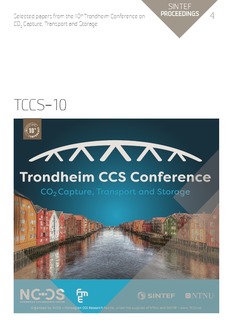High Concentrated Mea Solvent Systems for CO2 Absorption - An FT-NIR and Raman Spectroscopic Investigation
Jinadasa, M.H. Wathsala N.; Badalge, Jayalanka Liyana; Halstensen, Maths; Eimer, Dag; Jens, Klaus-Joachim
Chapter, Conference object, Peer reviewed, Chapter
Published version
Date
2019Metadata
Show full item recordCollections
- SINTEF Community [2247]
- SINTEF Proceedings [402]
Abstract
This study investigates the use of Fourier Transform Near-Infrared (FT-NIR) spectroscopy and Raman spectroscopy to monitor the CO2 absorption process when over 65 wt % concentrated monoethanolamine (MEA) solutions are used. Using high concentrated amines instead of the conventional 30 wt %, is a strategy to decrease the cost of CO2 capture plants by minimizing the energy consumption spent for amine regeneration and reducing the size of the process equipment. In addition, higher solvent concentration has a positive impact on mass transfer. CO2 loading and solvent strength are two main parameters that are used to characterize the well-known CO2 capture process by MEA. Several analytical methods are in practice to determine these two parameters but most of them are timeconsuming and not favourable when quick results are demanded. Process analyzers such as Raman spectroscopy or NIR (Near Infrared) spectroscopy can be used for real-time monitoring of chemical or physical attributes in a system and have advantages over traditional analytical methods. Authors have previously published spectroscopic methods combined with chemometrics to determine CO2 loading in 30 wt % MEA solutions by Raman spectroscopy in laboratory scale and pilot plant experiments. The aim of this paper is to extend these spectroscopic investigations when both the amine concentration and loading are spanned in a range. CO2 loading range was selected between 0- 0.6 mol CO2 / mol MEA and solvent concentration was varied between 66-99.5 wt %. Two analyzers were selected; Raman and Fourier transform near infrared (FT-NIR) spectrometers. It is relatively easy to generate data in a short time by these instruments, however identification of components of a chemical mixture and calibration methods become challenging as the FT-NIR and Raman spectral data are not straightforward. Many spectral responses appear similarly and therefore the choice of chemometrics methods is more reliable than the traditional univariate methods. In this study, chemometrics has been applied for data preprocessing, data exploration and finally for multivariate calibration of four models to predict CO2 loading and MEA concentration from FT-NIR and Raman spectroscopy.

